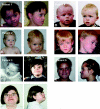Loss-of-function mutations in euchromatin histone methyl transferase 1 (EHMT1) cause the 9q34 subtelomeric deletion syndrome
- PMID: 16826528
- PMCID: PMC1559478
- DOI: 10.1086/505693
Loss-of-function mutations in euchromatin histone methyl transferase 1 (EHMT1) cause the 9q34 subtelomeric deletion syndrome
Abstract
A clinically recognizable 9q subtelomeric deletion syndrome has recently been established. Common features seen in these patients are severe mental retardation, hypotonia, brachycephaly, flat face with hypertelorism, synophrys, anteverted nares, cupid bow or tented upper lip, everted lower lip, prognathism, macroglossia, conotruncal heart defects, and behavioral problems. The minimal critical region responsible for this 9q subtelomeric deletion (9q-) syndrome has been estimated to be <1 Mb and comprises the euchromatin histone methyl transferase 1 gene (EHMT1). Previous studies suggested that haploinsufficiency for EHMT1 is causative for 9q subtelomeric deletion syndrome. We have performed a comprehensive mutation analysis of the EHMT1 gene in 23 patients with clinical presentations reminiscent of 9q subtelomeric deletion syndrome. This analysis revealed three additional microdeletions that comprise the EHMT1 gene, including one interstitial deletion that reduces the critical region for this syndrome. Most importantly, we identified two de novo mutations--a nonsense mutation and a frameshift mutation--in the EHMT1 gene in patients with a typical 9q- phenotype. These results establish that haploinsufficiency of EHMT1 is causative for 9q subtelomeric deletion syndrome.
Figures



Similar articles
-
Disruption of the gene Euchromatin Histone Methyl Transferase1 (Eu-HMTase1) is associated with the 9q34 subtelomeric deletion syndrome.J Med Genet. 2005 Apr;42(4):299-306. doi: 10.1136/jmg.2004.028464. J Med Genet. 2005. PMID: 15805155 Free PMC article.
-
Further clinical and molecular delineation of the 9q subtelomeric deletion syndrome supports a major contribution of EHMT1 haploinsufficiency to the core phenotype.J Med Genet. 2009 Sep;46(9):598-606. doi: 10.1136/jmg.2008.062950. Epub 2009 Mar 4. J Med Genet. 2009. PMID: 19264732
-
The chromosome 9q subtelomere deletion syndrome.Am J Med Genet C Semin Med Genet. 2007 Nov 15;145C(4):383-92. doi: 10.1002/ajmg.c.30148. Am J Med Genet C Semin Med Genet. 2007. PMID: 17910072 Review.
-
[Subtelomeric deletion 9qter: definition of the syndrome and parental origin in 2 patients].Med Clin (Barc). 2007 Mar 24;128(11):419-21. doi: 10.1157/13100343. Med Clin (Barc). 2007. PMID: 17394858 Spanish.
-
Three patients with terminal deletions within the subtelomeric region of chromosome 9q.Am J Med Genet A. 2005 Feb 1;132A(4):425-30. doi: 10.1002/ajmg.a.30496. Am J Med Genet A. 2005. PMID: 15633179 Review.
Cited by
-
Impairments in sensory-motor gating and information processing in a mouse model of Ehmt1 haploinsufficiency.Brain Neurosci Adv. 2020 Jun 18;4:2398212820928647. doi: 10.1177/2398212820928647. eCollection 2020 Jan-Dec. Brain Neurosci Adv. 2020. PMID: 32954001 Free PMC article.
-
Prdm6 controls heart development by regulating neural crest cell differentiation and migration.JCI Insight. 2022 Feb 2;7(4):e156046. doi: 10.1172/jci.insight.156046. JCI Insight. 2022. PMID: 35108221 Free PMC article.
-
Histone lysine methyltransferase-related neurodevelopmental disorders: current knowledge and saRNA future therapies.Front Cell Dev Biol. 2023 Feb 27;11:1090046. doi: 10.3389/fcell.2023.1090046. eCollection 2023. Front Cell Dev Biol. 2023. PMID: 36923252 Free PMC article. Review.
-
Molecular causes of sex-specific deficits in rodent models of neurodevelopmental disorders.J Neurosci Res. 2021 Jan;99(1):37-56. doi: 10.1002/jnr.24577. Epub 2019 Dec 23. J Neurosci Res. 2021. PMID: 31872500 Free PMC article. Review.
-
CDK19 is disrupted in a female patient with bilateral congenital retinal folds, microcephaly and mild mental retardation.Hum Genet. 2010 Sep;128(3):281-91. doi: 10.1007/s00439-010-0848-x. Epub 2010 Jun 22. Hum Genet. 2010. PMID: 20563892 Free PMC article.
References
Web Resources
-
- ESE Finder, http://www.genet.sickkids.on.ca/
-
- GenBank, http://www.ncbi.nlm.nih.gov/Genbank/ (for EHMT1 [accession number NM_024757])
-
- MRC-Holland, http://www.mrc-holland.com/
-
- NCBI Unified Library Database (UNILIB), http://www.ncbi.nlm.nih.gov/
-
- Online Mendelian Inheritance in Man (OMIM), http://www.ncbi.nlm.nih.gov/Omim (for Eu-HMTase1, Down syndrome, SMS, ATRX, and Rett syndrome)
References
-
- Harada N, Hatchwell E, Okamoto N, Tsukahara M, Kurosawa K, Kawame H, Kondoh T, Ohashi H, Tsukino R, Kondoh Y, Shimokawa O, Ida T, Nagai T, Fukushima Y, Yoshiura K, Niikawa N, Matsumoto N (2004) Subtelomere specific microarray based comparative genomic hybridisation: a rapid detection system for cryptic rearrangements in idiopathic mental retardation. J Med Genet 41:130–13610.1136/jmg.2003.014639 - DOI - PMC - PubMed
-
- Harada N, Visser R, Dawson A, Fukamachi M, Iwakoshi M, Okamoto N, Kishino T, Niikawa N, Matsumoto N (2004) A 1-Mb critical region in six patients with 9q34.3 terminal deletion syndrome. J Hum Genet 49:440–444 - PubMed
-
- Stewart DR, Huang A, Faravelli F, Anderlid BM, Medne L, Ciprero K, Kaur M, Rossi E, Tenconi R, Nordenskjold M, Gripp KW, Nicholson L, Meschino WS, Capua E, Quarrell OW, Flint J, Irons M, Giampietro PF, Schowalter DB, Zaleski CA, Malacarne M, Zackai EH, Spinner NB, Krantz ID (2004) Subtelomeric deletions of chromosome 9q: a novel microdeletion syndrome. Am J Med Genet A 128:340–35110.1002/ajmg.a.30136 - DOI - PubMed
-
- Neas KR, Smith JM, Chia N, Huseyin S, St. Heaps L, Peters G, Sholler G, Tzioumi D, Sillence DO, Mowat D (2005) Three patients with terminal deletions within the subtelomeric region of chromosome 9q. Am J Med Genet A 132:425–430 - PubMed
Publication types
MeSH terms
Substances
Associated data
- Actions
LinkOut - more resources
Full Text Sources
Other Literature Sources
Medical
Molecular Biology Databases
Miscellaneous

